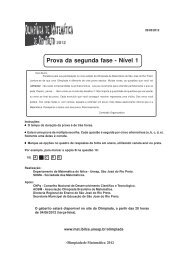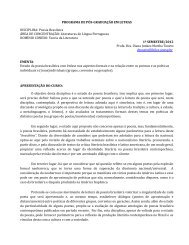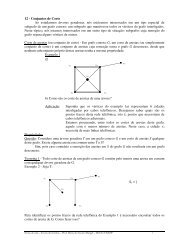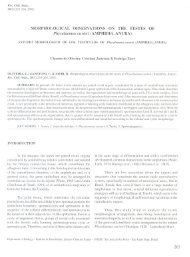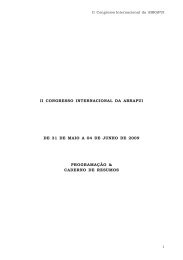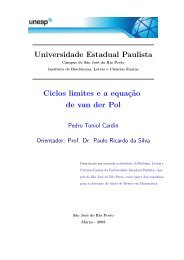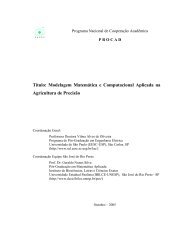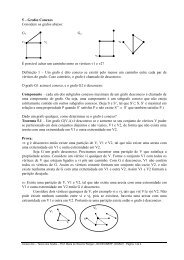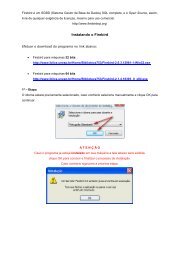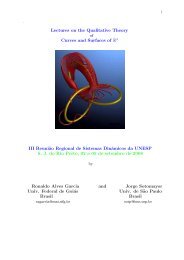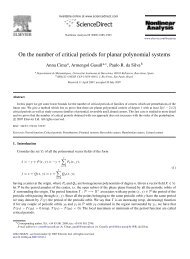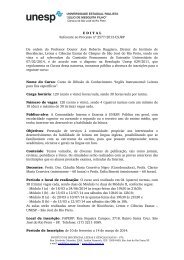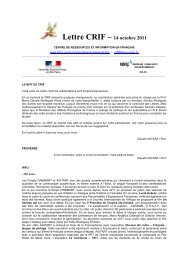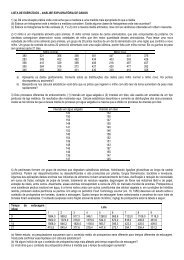- Page 1 and 2:
UNIVERSIDADE ESTADUAL PAULISTAInsti
- Page 3 and 4:
“A mathematician is a machine for
- Page 5 and 6:
Sumário1 Introdução às equaçõ
- Page 7 and 8:
Capítulo1Introdução às equaçõ
- Page 9 and 10:
1.1 Teoria preliminarA equação (1
- Page 11 and 12:
1.1 Teoria preliminarprimeiras pot
- Page 13 and 14:
1.1 Teoria preliminarDe fato,f ′
- Page 15 and 16:
1.1 Teoria preliminarSubstituindo a
- Page 17 and 18:
1.1 Teoria preliminarDerivando duas
- Page 19 and 20:
1.1 Teoria preliminardos tipos de p
- Page 22 and 23:
1 Introdução às equações difer
- Page 24 and 25:
2 Equações lineares de primeira o
- Page 26 and 27:
2 Equações lineares de primeira o
- Page 28 and 29:
2 Equações lineares de primeira o
- Page 30 and 31:
2 Equações lineares de primeira o
- Page 32 and 33:
2 Equações lineares de primeira o
- Page 34 and 35:
2 Equações lineares de primeira o
- Page 36 and 37:
2 Equações lineares de primeira o
- Page 38 and 39:
2 Equações lineares de primeira o
- Page 40 and 41:
2 Equações lineares de primeira o
- Page 42 and 43:
2 Equações lineares de primeira o
- Page 44 and 45:
2 Equações lineares de primeira o
- Page 46 and 47:
2 Equações lineares de primeira o
- Page 48 and 49:
2 Equações lineares de primeira o
- Page 50 and 51:
2 Equações lineares de primeira o
- Page 52 and 53:
2 Equações lineares de primeira o
- Page 54 and 55:
2 Equações lineares de primeira o
- Page 56 and 57:
German Lozada CruzMatemática-IBILC
- Page 58 and 59:
3 Equações não-lineares de prime
- Page 60 and 61:
3 Equações não-lineares de prime
- Page 62 and 63:
3 Equações não-lineares de prime
- Page 64 and 65:
3 Equações não-lineares de prime
- Page 66 and 67:
3 Equações não-lineares de prime
- Page 68 and 69: 3 Equações não-lineares de prime
- Page 70 and 71: 3 Equações não-lineares de prime
- Page 72 and 73: 3 Equações não-lineares de prime
- Page 74 and 75: 3 Equações não-lineares de prime
- Page 76 and 77: 3 Equações não-lineares de prime
- Page 78 and 79: 3 Equações não-lineares de prime
- Page 80 and 81: 3 Equações não-lineares de prime
- Page 82 and 83: 3 Equações não-lineares de prime
- Page 84 and 85: 3 Equações não-lineares de prime
- Page 86 and 87: 3 Equações não-lineares de prime
- Page 88 and 89: 3 Equações não-lineares de prime
- Page 90 and 91: 4 Equações lineares de segunda or
- Page 92 and 93: 4 Equações lineares de segunda or
- Page 94 and 95: 4 Equações lineares de segunda or
- Page 96 and 97: 4 Equações lineares de segunda or
- Page 98 and 99: 4 Equações lineares de segunda or
- Page 100 and 101: 4 Equações lineares de segunda or
- Page 102 and 103: 4 Equações lineares de segunda or
- Page 104 and 105: 4 Equações lineares de segunda or
- Page 106 and 107: 4 Equações lineares de segunda or
- Page 108 and 109: 4 Equações lineares de segunda or
- Page 110 and 111: 4 Equações lineares de segunda or
- Page 112 and 113: 4 Equações lineares de segunda or
- Page 114 and 115: 4 Equações lineares de segunda or
- Page 116 and 117: 4 Equações lineares de segunda or
- Page 120 and 121: 4 Equações lineares de segunda or
- Page 122 and 123: 4 Equações lineares de segunda or
- Page 124 and 125: German Lozada CruzMatemática-IBILC
- Page 126 and 127: 5 Sistemas lineares bidimensionaisD
- Page 128 and 129: 5 Sistemas lineares bidimensionaisP
- Page 130 and 131: 5 Sistemas lineares bidimensionaisO
- Page 132 and 133: 5 Sistemas lineares bidimensionaisN
- Page 134 and 135: 5 Sistemas lineares bidimensionaisa
- Page 136 and 137: 5 Sistemas lineares bidimensionaisa
- Page 138 and 139: 5 Sistemas lineares bidimensionaisq
- Page 140 and 141: 5 Sistemas lineares bidimensionaisA
- Page 142: German Lozada CruzMatemática-IBILC



